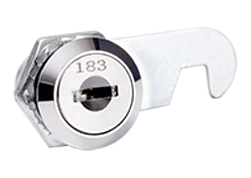The inner workings of a combination cam lock typically involve a set of rotating discs or wheels with notches or teeth that align to create a specific combination. Here's a breakdown of the components and their functions for combination cam locks Manufacturers:
Outer Housing: The outer housing encloses the internal mechanism of the combination cam lock and provides protection and stability.
Dial or Knob: The dial or knob is the visible part of the lock that the user interacts with. It typically has numbers or symbols printed on it and can be rotated.
Cam: The cam is a rotating metal plate or lever connected to the internal mechanism. It is responsible for locking or unlocking the desired mechanism, such as a cabinet door or a locker.
Driver Pins: Driver pins are small metal pins that are arranged radially within the lock mechanism. They are spring-loaded and align with the notches or teeth on the rotating discs.
Rotating Discs or Wheels: These discs or wheels have notches or teeth cut into their edges. The number of discs or wheels may vary depending on the lock design. Each disc has a corresponding driver pin that rests in its notches.
Notches or Teeth: The notches or teeth on the discs are aligned in a specific pattern to create the combination. When the correct combination is dialed, the notches align with the driver pins, allowing them to be pushed flush with the surface of the discs.
Gate or Fence: The gate or fence is a metal piece located within the lock mechanism. It prevents the cam from rotating unless the correct combination is dialed. The gate is designed to align with the notches on the discs when the correct combination is entered.
When the user dials the correct combination, the driver pins align with the notches on the discs, creating a gap between the discs and allowing the gate to align with the notches as well. This alignment enables the cam to rotate freely, unlocking the desired mechanism. If an incorrect combination is dialed, the driver pins will not align with the notches, preventing the gate from aligning properly and inhibiting the rotation of the cam, thereby maintaining the lock's security.




 English
English 中文简体
中文简体
















